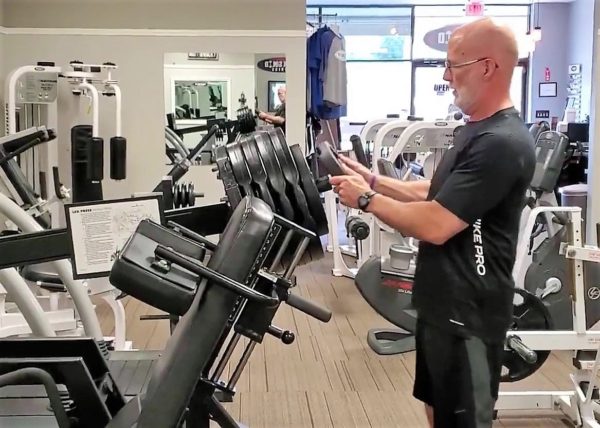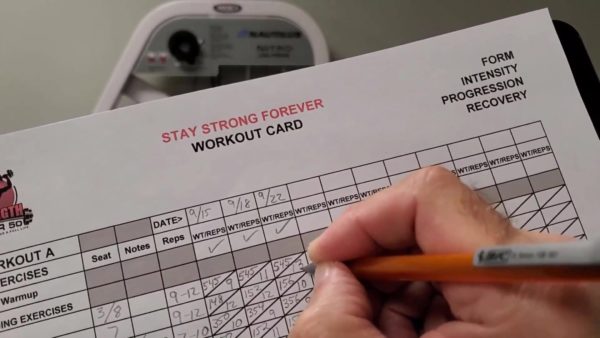It’s easy enough for people over 50 to go for a walk or bike ride, but figuring out how to do strength training over 50 can get downright confusing.
How often should you weight train? How much weight should you lift? How many repetitions and sets are best for your goals?
And this confusion often tempts people to skip it altogether, missing out on the many documented health benefits of weight training after 50.
As the years pass, muscle mass in the body generally shrinks, and strength and power decline. On average, adults who don’t do regular strength training can expect to lose 4 to 6 pounds of muscle per decade. (Harvard.health.edu)
This age-related muscle loss, known as sarcopenia, slows your metabolism (muscle burns calories at rest) and increases risk of falls.
And it gets worse – assuming we maintain the same eating habits, that lost muscle will be replaced by stored body fat. So even if our bodyweight stays the same over the years, we are actually getting weaker and fatter as a natural consequence of aging.
The point is that if we don’t do anything, we don’t stay the same, we actually get worse, because our ability to function independently and our overall health are being eroded just by the passage of time.
The best way to mitigate the these negative effects is consistent progressive resistance exercise, or strength training. Regularly imposing a challenging demand on your muscles will keep them strong, and counteract the muscle-wasting effects of sarcopenia.
For these reasons, men and women over 50 stand to gain more from properly performed strength training than when they were younger.

This post will go over everything you need to know about strength training over 50 to gain all the benefits it has to offer in the safest and most time-efficient way possible.
Related content on strength training over 50:
-
Is Building Muscle After 50 Really Something You Can Realistically Achieve?
-
How To Achieve Excellent Fitness Over 50 in 90 Minutes A Week
-
10 Home Gym Essentials On A Budget For Full Body Workouts To Get You Strong Really Fast
Strength Training Over 50: What You Need To Know
How often should you strength train over 50?
Many people seem to be trying to figure out how much exercise they can cram into their schedule. This is the result of having a “more is better” mentality.
The problem with this approach is that recovery time between strength training workouts is when your body actually produces the increase in muscular strength that was stimulated by the workout. And now that we’re older, we need more time to recover than we did in our 20’s to allow those changes to take place.
When you finish an intense workout, you don’t feel the same as you did before you started – you feel very fatigued. The reason is you used up a lot of energy resources within your body to complete the workout – in effect you have dug an energy hole.
The first thing your body has to do is fill in that hole, that is, compensate for the exhaustive effects of the workout. Only once that’s completed can your body over-compensate in the form of bigger, stronger muscles – pile some extra muscle on top of where that hole used to be.
And this process doesn’t take a few hours when you’re over 50, it takes a few days. If you work out again before the whole process is complete, you won’t get any strength building benefit from your last workout.
So I recommend people over 50 strength train no more than twice a week, with at least 2 recovery days in between workouts.
Can I work out on back-to-back days?
A popular way of working out is what is known as a “split routine”.
With a split routine, you work out multiple times a week, but segment your training so you are only exercising certain body parts in any given workout.
For example, Monday is chest and back day; Tuesday is shoulders and arms day; Wednesday is leg day. Then Thursday you start over again with chest and back.
But there’s a big flaw with this system, and it is not the best way to do your strength training after 50.
Recovery is just as important to your results as the workout. The workout must come first; it is the stimulus, the thing that flips the switch and sets muscular change into motion. But recovery time is when those changes take place.
And the full recovery process, from stimulus to recovery to overcompensation, can’t be fully completed in 24 hours, especially for older trainees.
Here’s the big flaw. Although you are exercising different muscle groups each day, you only have one recovery group.
When you perform a vigorous strength training workout, you don’t feel the same right afterwards as you did before the workout; you feel fatigued, even a bit drained. Why? Because you used up a lot of resources during the workout.
The first thing your body does after the workout is replenish those resources. But that task is not performed by your muscles; recovery is completed by a few subsystems within your body, like your digestive system, your endocrine system, your circulatory system, and your digestive system.
And although you have over 600 muscles in your body, you only have one of each of those subsystems. And those systems are responsible for helping you recover from everything you do, whether its chest day, leg day, hiking up a big mountain, or moving furniture.
In other words, you only have one gas tank to fuel all of your workouts (and everything else you do), and if you take a long trip on Monday, you have to let the gas tank fill up again before your next trip.
If you workout on Monday, then go right back to the gym and do it again on Tuesday, you won’t get any benefit from Monday’s workout, because you short-circuited the recovery process.
That’s why lifting weights every day is a mistake, even if you are training different parts of your body. There is an overall energy drain on your body, and eventually you will get burned out.
Training your full body as a unit, then resting it as a unit, is a much more productive method of strength training when you’re over 50.
How long should a strength training workout be?
For your body to change from your strength training, you have to give it a good reason to do so. If you can lift 50 pounds on a certain exercise for 10 reps, but you always stop at 8 reps, why should your body alter itself? It has no reason to.
On the other hand, if you did 10 reps last time, and today you try for 11 reps, you have sent a signal to your body that the current condition of that muscle is insufficient, and it needs to get stronger and bigger to deal with these demands.
So the workout has to be intense – as close to a maximum effort as possible.
And if you make the intensity of your workout high, which is necessary to get stronger, it will necessarily be brief, because intensity of effort and duration of effort are inversely proportional.
In simple terms, you can either strength train hard, or you can train for a long time, but you can’t do both. And training hard for a short period of time is what will give you the best results. It’s the exercise equivalent of using a tanning bed to get a suntan.
This is great news, because if you’re willing to commit to putting in a maximum effort, you can complete a full body workout in under 45 minutes.

How many sets and reps are best?
Intensity is the one factor in your workout that stimulates your muscles to get bigger and stronger. The higher the intensity on
each set you do, the better your results will be.
Your goal on every set is to reach 100% intensity, the highest possible level, which means exerting a maximum effort. The last rep you perform in each set you do should be the last rep you can possibly perform with proper form.

When you work out in this fashion, only one set of each exercise is necessary.
How much weight should I use?
One of the trickiest parts of the program when you are first starting out is selecting the right amount of weight to use for each exercise. Initially, this will take some experimentation on your part, but you should have it figured out by your third workout at the latest.
Your goal is to find a weight that allows you to perform at least the minimum number in the rep range, but not more than the maximum number.
When you are first starting out, you will have to take a guess, pick a weight, and start performing reps with proper form, aiming for the suggested rep range (9-12 for legs and midsection, 7-10 for upper body).
If you reach the upper level of the rep range easily, the weight is too light. If you can’t get to the minimum number, the weight is too heavy. And if you are forced to stop due to muscular fatigue somewhere between the minimum number and the upper level number of the given rep range, the weight is just right.
Once you have it just right, you stick with that weight until you hit the high number of the rep range. Then, on your next workout, you will increase the weight by 2 ½ to 5 pounds.

Using this method, you will make continuous progress for a long time by increasing either the amount of reps you do, or the amount of weight you use, or both, every workout.
How do I know when it’s time to increase resistance?
To reach your ultimate fitness destination you need to make small, progressive steps every workout. Using a “rep range” will give you a repetition target to shoot for every workout, as well as allow you to compete with yourself by trying to exceed what you did in your last workout. A good rep range for leg and midsection exercises is 9 to 12, and for upper body exercises 7-10.
Here’s how using a rep range works. Let’s say you are performing a strength training exercise using 150 pounds, and your rep range is 9 to 12. You perform 10 perfect reps, but no matter how hard you try, you cannot complete an 11th rep.
You completed 10 reps, so you surpassed the minimum of 9, but did not reach or exceed the upper limit of 12, so for now you stick with that weight. Whenever you get to the point where you can perform 12 or more reps with 150 pounds (with perfect form of course), you will increase the weight slightly on your next workout, say to 155 pounds.
You stick with 155 until you can perform 12 or more reps with that weight, however many workouts that takes, then move the weight up slightly again, which should knock you back down to 9-12 reps.
This system enables you to make consistent, measurable progress continuously, right from your first workout, and
will enable you to look, feel and perform better in the shortest possible amount of time.
Any other tips I need to know?
What is the best workout for a 50 year old man or woman?
First off, a strength training workout for men or women over 50 should look the same, because we all have the same muscles, and the physiological process that causes an increase in muscular strength is the same for all of us.
Whether we’re male or female, once we’re over 50, we want to not only strength train the large, superficial muscles of the body, which are readily visible, but also the smaller deep muscles of the body, which serve to hold us together and protect us from injury. So a good strength training workout for someone over 50 will include exercises for both.
Before starting the actual workout, I recommend you spend a few minutes warming up. This will increase your internal temperature a little and prepare your body for the workout, like warming up a car before driving on a cold day.
You want to make sure your warm-up includes movement in both your upper and lower body. If you have an elliptical machine or air bike available that will do the trick. If you don’t, you can use a bike or treadmill for 3-5 minutes for your lower body, and perform a few simple movements with light dumbbells for your upper body.
Just be sure not to turn your warm-up into a workout of its own – you want to do just enough so that you feel you won’t injure yourself, and save your strength for the actual workout.
For the large superficial muscles – these are the ones everyone knows about; the pecs, the biceps, the abs the glutes, etc. – you can cover your full body with 5 different movements:
- A lower body push, such as a leg press exercise, where you are extending or straightening your knees and hips;
- Next is lower body flexion, which can alternate between knee flexion, or bending, such as a leg curl exercise – and plantar flexion of the ankles, which mimics pushing the gas pedal and involves your calf muscles, such as a seated or standing calf raise.
- Third on our list is an upper body push, which would involve straightening the elbows, such as a barbell bench press, chest press machine, or overhead press;
- Then we add an upper body pull, an exercise where we’re bending the elbows, such as a pulldown, row or chin up;
- And the 5th one is a midsection exercise, either trunk flexion for the abdominals, or trunk extension for the low back muscles, on a machine or a specially designed bench.
Now we move on to the smaller deep muscles of the body, such as the rotator cuff muscles of the shoulder, the neck muscles, or the gripping muscles in our hands. I call exercises for these muscle groups Rebuilding exercises.
You want to pick exercises for areas of your body that have either been injured in the past, or that you feel are especially vulnerable to injuries in the future. So the exact exercises vary based on each individual’s personal situation, medical history, and available equipment.
I usually recommend 3 of these rebuilding exercises per workout, bringing the total number of exercises performed to 8.
After the strength training workout is a great time to do a little stretching, especially for the shoulders and hips, which tend to lose flexibility as we get older.
Once you get the hang of things, this whole process takes under 45 minutes, and you only need to do it once or twice a week. (Ncbi.nlm.nih.gov)
Ready to get started on a safe, sustainable, time-efficient workout program for over-50’s? Click here to learn more.




4 Comments. Leave new
As always, great info. Hope you guys (traditional term for 2+ humans independent of sex) are well.
Thank you Tom, great to hear from you! Hope you’re still killing it in the gym.
Thanks Dave, Extremely helpful information. 2 quick questions; Do you recommend light warm up sets for main exercises and what’s your recommended set/rep range for the rebuilding movements?
Thank you!
Hi Ben, glad you found the information helpful. I recommend a general warmup before the workout starts, just a few minutes of light movement to get the blood flowing. On main exercises, a warmup set with 50% of your working weight for 4-6 reps is a nice specific warmup.
The bottom line with warmups is this: do whatever you feel you need to do so you won’t injury yourself on your heavy set, and limit it to that amount. Don’t turn your warmup into a workout.
For rebuilding movements, I recommend 1 set of 9-12 reps.